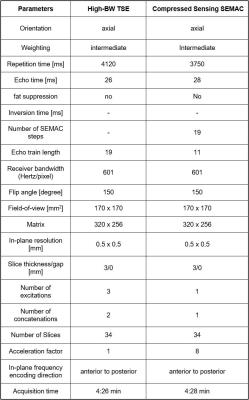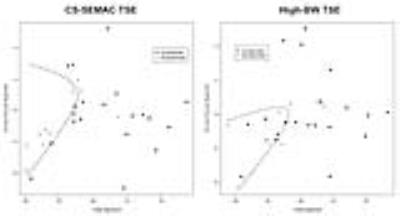0649
Metal Artifact Reduction MRI for the Assessment of the Rotational Alignment Knee Arthroplasty Implants: Compressed Sensing SEMAC TSE versus High-Bandwidth TSE1Radiology, The Johns Hopkins University School of Medicine, Baltimore, MD, United States, 2Radiology, Ospedale Regionale di Lugano, Lugano, Switzerland, 3Radiology, Orthopedic University Hospital Balgrist, Zurich, Switzerland, 4Radiology, The Johns Hopkins University School of Medicine, Baltimore, MD, 5Queensland University of Technology
Synopsis
Malrotation of knee arthroplasty implants is a source of pain following total knee arthroplasty and maybe measured on metal artifact reduction MR images; however, it is unclear which technique is best. Therefore, we compared the reliability, repeatability, and precision of rotational alignment measurements that were obtained on optimized high-bandwidth and compressed sensing SEMAC TSE MR images and their relationships with symptoms. CS-SEMAC TSE MRI afforded the highest reliability, repeatability and precision of rotational alignment measurements, which correlate best with symptoms. CS-SEMAC TSE MRI may be preferred over high-BW TSE for rotational alignment measurements of knee arthroplasty implants.
Introduction
Malrotation of knee arthroplasty implants is an important source of patellofemoral complications and pain following total knee arthroplasty [1]. Rotational alignment measurements are often performed with computed tomography. However, metal artifact reduction MRI utilizing optimized fast and turbo spin echo (TSE) pulse sequences with high receiver bandwidth (BW) also permits those measurements [2], yet remaining metal artifacts may interfere with its accuracy. Compressed sensing-(CS)-based acceleration for Slice Encoding for Metal Artifact Correction (SEMAC) turbo spin echo (TSE) MRI has recently been introduced for high–quality metal artifact reduction MRI around arthroplasty implants [3,4]. An 8-fold-accelerated CS-SEMAC pulse sequence can shorten the sampling time by up to 60%, thus enabling the times neutral use of SEMAC and offering an efficient option to improve the accuracy of MRI-based rotational alignment measurements [5].Purpose
To compare the reliability, repeatability, and precision of optimized high-BW TSE and CS-SEMAC TSE pulse sequences for rotational alignment measurements of total knee arthroplasty implants and to assess the relationships between rotational misalignment measurements and pain following total knee arthroplasty.Methods
This study was approved by our institutional review board. Informed consent was obtained from all participating subjects. Twenty symptomatic subjects with suspected misalignment and 10 asymptomatic subjects with total knee arthroplasty underwent MRI of the knee using a clinical 1.5 Tesla MR imaging system (MAGNETOM Aera, Siemens Healthcare, Erlangen, Germany) and 15-channel transmit-receive knee coil. The study protocol consisted of axial high-BW TSE and 8-fold accelerated CS-SEMAC pulse sequences (Figure 1) of similar acquisition time. CS-SEMAC used 19 SEMAC-encoding steps and acceleration through incoherent undersampling of the 2D-phase encoding matrix and non-linear, SENSE-type reconstruction with L1-norm-based regularization was used [6]. Three fellowship-trained musculoskeletal radiologists measured twice the surgical (sTEA), the clinical femoral (cTEA) and the tibial rotational alignment (TA).sTEA alignment was defined as the angle between the line connecting the most prominent points of the lateral epicondyle with the medial epicondylar sulcus and the line connecting the medial and lateral dorsal condylar surface. cTEA alignment was defined as the angle between the line connecting the most prominent point of the medial and lateral component for cTEA and the line connecting the medial and lateral dorsal condylar surface. TA was defined as the angle between the line connecting the geometrical center of the tibial component of the TKA and the perpendicular line to the posterior component [1]. Measurements repeatability, reader reliability, measurement precision and relationship between knee pain and misalignment were assessed with concordance correlation (CC), interclass correlation (ICC) and quadratic logistic discrimination, respectively.Results
The concordance correlation with 95% confidence intervals showed higher repeatability of measurements for CS-SEMAC, whereas sTEA had a better repeatability than cTEA for both CS-SEMAC and high BW TSE (Figure 2). Bland-Altman plots of each of the measurements in each of the image types demonstrated higher concordance of results for CS-SEMAC (Figure 3) and notably less consistent negative measurement values for high-BW TSE. Inter-reader reliability was generally high, but higher for CS-SEMAC than for high-BW TSE [Figure 4]. Further, the precision of measurements was higher for CS-SEMAC as indicated by lower inter-reader standard deviations. The quadratic logistic discrimination indicated a subject should be predicted as asymptomatic, whenever 0.403*cTEA2 – 0.174*cTEA*TA – 0.023*TA2 – 3.083*cTEA – 0.789*TA – 5.999 < 0 (Figure 5). For CS-SEMAC, quadratic logistic discrimination further indicated that the difference of the clinical femoral and tibial alignment of asymptomatic patients ranges between 21 and 24 degrees as long as the tibial alignment angle is not larger than -20 degrees.Discussion
Our results demonstrate the successful use of CS-SEMAC TSE MRI for the assessment of rotational implant alignment after total knee arthroplasty. Owing to compressed sensing-based undersampling, there was no difference in the acquisition time of high-BW and CS-SEMAC TSE, although the iterative reconstruction process of CS-SEMAC required approximately 4 minutes at the time of the study. When compared to optimized high-BW TSE, CS-SEMAC TSE shows higher repeatability, higher reliability, and better ability to identify abnormal alignment in symptomatic and asymptomatic subject, which we believe is due to less metal artifacts with CS-SEMAC and resulted in decreased distortions, signal displacement and observers’ ability to identify the pertinent anatomic land marks.Conclusions
CS-SEMAC TSE MRI of the knee affords higher reliability, repeatability and precision of rotational alignment measurements of knee arthroplasty implants, which correlate better with symptoms. CS-SEMAC TSE MRI may be preferred over high-BW TSE for rotational alignment measurements of knee arthroplasty implants.Acknowledgements
No acknowledgement found.References
1. Berger RA, Crossett LS, Jacobs JJ, Rubash HE. Malrotation causing patellofemoral complications after total knee arthroplasty. Clin Orthop Relat Res. 1998 Nov;(356):144-53.
2. Heyse TJ, Chong le R, Davis J, Boettner F, Haas SB, Potter HG. MRI analysis for rotation of total knee components. Knee. 2012 Oct;19(5):571-5.
3. Lu W, Pauly KB, Gold GE, Pauly JM, Hargreaves BA. SEMAC: Slice Encoding for Metal Artifact Correction in MRI. Magn Reson Med. 2009 Jul;62(1):66-76. doi: 10.1002/mrm.21967.
4. Fritz J, Ahlawat S, Demehri S, Thawait GK, Raithel E, Gilson WD, Nittka M. Compressed Sensing SEMAC: 8-fold Accelerated High Resolution Metal Artifact Reduction MRI of Cobalt-Chromium Knee Arthroplasty Implants. Invest Radiol. 2016 Oct;51(10):666-76
5. Fritz J, Fritz B, Thawait GK, Raithel E, Gilson WD, Nittka M, Mont MA. Advanced metal artifact reduction MRI of metal-on-metal hip resurfacing arthroplasty implants: compressed sensing acceleration enables the time-neutral use of SEMAC. Skeletal Radiol. 2016 Oct;45(10):1345-56.
6. Liu j, Rapin J, Chang T, Schmit P, Bi X, Lefebvre A, Zenge M, Mueller E, Nadar M. Regularized reconstruction using redundant Haar wavelets: A means to achieve high under-sampling factors in non-contrast-enhanced 4D MRA. ", Proceeding of the International Society for Magnetic Resonance in Medicine, 20TH Annual Meeting and Exhibition, Melbourne, Australia, 5-11 May 2012, Vol. 20, 21 April 2012 (2012-04-21), pages 2237.
Figures




